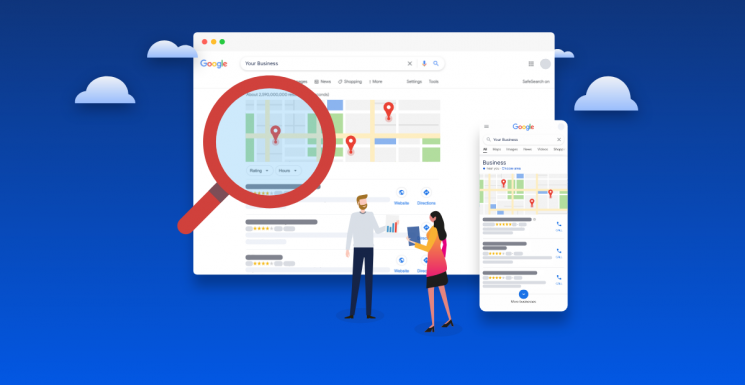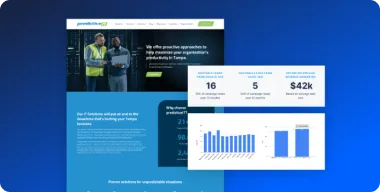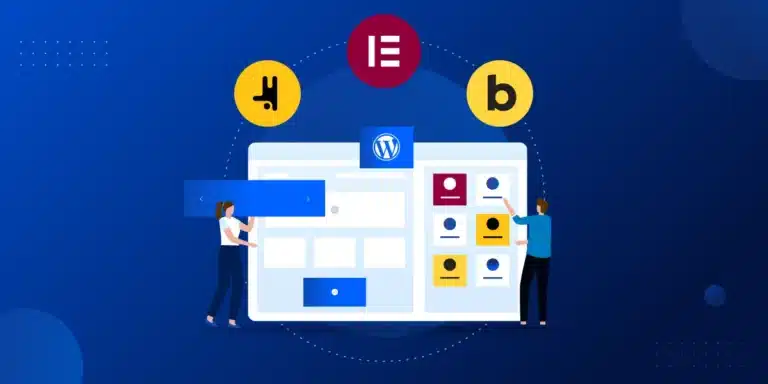How do you get information about the nearest open pharmacy at 11:30 PM on a Saturday night? If you are like most people in 2025, you are going to pull the phone out of your pocket and start Googling something like “pharmacy near me” or “pharmacy in city name”. You’ll then be presented with a list of pharmacies in the proximity of where you performed your search.
Through a practice called local SEO, those pharmacies have been able to optimize their websites or map listings and appear at the top of your search results in the moment of most need.
If you run a local business that allows walk-ins, face-to-face interactions with customers, or serves a clear geographic location, then local SEO should be a top priority on your marketing to-do list for this year.
Here we have listed 34 of the most effective local SEO tips that will help your business increase its exposure in local search results:
Google My Business Optimization
Google My Business is an essential free tool provided by Google for local businesses to control their presence across their search engine and Google Maps. A well optimized Google My Business listing will allow potential customers to be presented with the most relevant features of your business as well as a number of options to get in touch with you.
After claiming or creating your listing you’ll be able to start optimizing your listing including what categories you’d like your business to show up for, a feature to upload images of your location and staff, to write timely updates, and respond to customer reviews and questions.
All this comes with a nifty analytics dashboard that provides useful information like what search terms are being shown the most for your listing.
1. Claim Your Google My Business Listing
If your business has been around for a while, there could already be a listing for it on Google Maps. It’s important to check for an existing listing first to avoid creating a duplicate listing and having to remove it later. Here are the steps to finding and claiming your Google My Business listing:
- Open Google Maps and type your business name in the search bar.
- Select your business.
- Click Claim this business > Manage now.
- Select a verification option, and follow the steps.
If your business is new or you can’t find it, you can create a listing from scratch. The best way to do this is to sign in to Google My Business with a Google login and continue through the steps.
2. Don’t Use a Virtual Address
This is a quick and straightforward tip that can save you a lot of headache. When creating or moving your Google My Business listing, don’t use a virtual address. Google’s guidelines do not allow virtual addresses or P.O. boxes, so if you use one, your listing could be suspended. Instead, use a home address and hide the location.
3. The Registered Address Matters (Even If It’s Hidden)
The area around the registered address is more likely to appear in search results than other areas, so if you don’t have a shop or office, and have several available addresses to send a postcard to, choosing the address where your customers are could help.
4. Add Your Service Area
Service areas help let your customers know what areas you serve. Adding your service area won’t do much to boost your position on search results like listing your physical location can, but it will be useful for your customers to know if you operate in their area.
5. Use a Location Page for the Website Link (If You Have One)
Usually, businesses link their website’s homepage to the ‘Website’ button of their Google listing. According to Moz, businesses with more than one location should instead consider linking to a dedicated location page, as this leads to higher rankings. (We’ll talk more about location pages later too).
This could make sense for the customer (and Google), since if they are searching for IT services in Boston and you have a Boston office dedicated location page for that area, then this is the most relevant page for the customer to land on.
6. Choose Your Business Categories (But Not Too Many)
Choosing the right categories has a direct and large impact on when you appear in search results. Google has over 3,000+ different categories from which you can choose up to 10, with 1 option for the primary category. Choosing your categories is pretty straightforward but there are three things to consider when doing so:
- Primary category –This has the greatest impact on search results, so choose the best one that describes your business.
- Secondary categories – The more secondary categories you choose, the more diluted their impact becomes. Google recommends using “as few categories as possible to describe your overall core business from the provided list.” So we usually recommend using one primary category and three secondary categories.
- Spy on your competitors – Because there are 3,000+ categories, it might be hard to know which ones are available, and which ones best suit your business. An easy way to check is to search for the local service you want to show up for, then use a tool like GMB Spy to see what categories your competitors have.
7. Get Reviews (Higher Quality & More Than the Competition)
Reviews are critical to the success of your Google My Business listing. This is because they have a direct impact on your search rankings. A survey shows that over 30% of customers will visit a website after reading a positive review.
Even though they are so important, reviews are often overlooked by many businesses. So, obtaining more, higher-quality reviews can really help you beat the competition in local search results.
Once you’ve created your Google My Business account, Google will supply a link that takes you directly to your Google My Business page. If you’d like to use a link that goes directly to asking for a review, you can follow these steps:
- Go to Google Place ID website.
- Write your company name in the “Enter a location” field on the map.
- Select your company and copy the places ID.
- Add the ID after the
=. https://search.google.com/local/writereview?placeid=- Share the link with your customers
Just remember to obtain reviews from your existing, happy customers. Google has their way of finding out if a review is not genuine, including looking at the IP of the reviewer (so avoid asking anyone on the office/shop WiFi to leave a review).
8. Reply to All Reviews (Especially Negative Ones)
This tip is more about brand management than a ranking factor, but it’s still a very important one to remember. Because replies to reviews are public, you’re not only speaking to the person who left a review, but also to any other person who’s reading it. So, whenever you receive a review, keep the following in mind:
- Reply sooner rather than later – Customers will appreciate your attentiveness.
- Say thank you – Simple
- Avoid canned responses – A unique, personal response will go a long way in making customers happy.
- Repeat any specific point – If the reviewer mentions something specific they liked, feel free to mention that in the response. For example, “I’m glad you liked how efficient we were. We pride ourselves on our quick and organized processes.”
If you receive a negative reply, pause and try your best to understand the problem. Then apologize to the customer and try to take the conversation offline by giving a customer service email or number. When writing your response, remember that you’re also writing for future readers.
9. Write Common Questions & Answers
Another overlooked feature of your Google Maps listing is the Questions and Answers feature. This is where consumers will ask questions about a business like “Are you open on Sunday?” or “What services do they offer?”. If you use this features, keep in mind that:
- You can’t reply to questions within Google My Business.
- Questions and answers have to be submitted in your listing on Google Maps/Google Search.
- Because of this, anyone can reply to questions.
Whenever you receive a question, you’ll have to answer it directly on Google Search/Maps. If you’re logged into your Google account that’s connected to your Google My Business profile, the reply will use your Google My Business logo as the avatar, so the person asking the question will know the reply is from the business. Here’s a couple of tips to remember:
- Reply sooner than later – Since anyone can leave an answer to any question, it’s important to reply quickly so that you can leave an accurate answer.
- Write your own Q&As – You don’t have to wait for someone to ask a question. If you already know what your customers usually ask, you can write the question on their behalf, then answer it yourself.
10. Upload Photos (Regularly)
Anyone can add a photo to your listing, but it’s important that you also take control of the image you want your company to portray by posting photos including:
- 360 photos
- Photos of your team at work
- Logo
- Cover photo
- Team photos
Here’re some tips when adding photos:
- Upload photos every seven days – Photos you upload will be viewable in Google’s search results for seven days after posting. After this period, someone can still see your photos by accessing your listing.
- Geotag your photos – If you’re uploading photos from a phone, they will usually come with the GPS coordinates embedded, which Google will use as a local signal. If you’re uploading from a digital camera, you can use websites like this one to add geotags to your photos.
- Natural but professional – Google has photo quality guidelines for businesses uploading photos. According to Google, the photos should be “in focus, well-lit, have no photoshop alterations, and no excessive use of filters. The image should represent reality.”
11. Create Posts Regularly
You can think of posts on Google My Business like posts on Facebook or Twitter, although they show up on Google Search and Google Maps as part of your listing. The beauty of Google My Business posts is they can help you communicate timely and relevant information directly to customers .
Like photos, posts help increase the authenticity of your profile. Also like photos, new posts are automatically displayed on your page for seven days, so it’s a good idea to post every week to keep your profile fresh and up to date. Some of the posts you can do include:
- What’s new
- Events
- Offers
- Products
- Hours updates (this happens automatically when you update the business hours)
Optimize your Website Pages (aka On-Page SEO Optimization)
As well as Google My Business, on-page optimization is vital in improving your chances of ranking for local searches.
12. Research Local Keywords
Making sure you are targeting local keywords is essential, especially for companies that don’t have a physical shop/office but service multiple areas nonetheless.
The best location keywords usually have the formula “service + location” or “location + service” (e.g., “personal injury lawyers NYC”). Once you’ve decided on the best location keyword(s) for your business, you should then create pages dedicated to the keywords.
Not all location keywords are created equally, though, so it’s important to put your keyword ideas into a keyword research tool to look at the monthly search volume versus the difficulty of ranking for that keyword. We use Ahrefs, which is a paid tool, but there are many other options, both paid and free. These include:
- KW Finder (paid)
- SEMrush (paid)
- Keywords Everywhere (free/paid)
- Google Keyword Planner (free)
- Google Search Console (free)
13. Spy on Your Competitor’s Keywords to See What Works
Researching keywords can be a hit-and-miss — you can end up spending a great deal of time doing it and not get the results you want. Looking at your competitors’ keywords will save you a lot of time and give you an idea of what keywords could also work for you.
Most keyword research tools give you the option to add your competitors’ websites to see what keywords are ranking well for them. All you need to do is input each competitor’s website URL. You’ll then be presented with a list of local keywords that you can also use.
Do take note of the keyword difficulty. Most paid keyword tools indicate how difficult it is for a website to rank for a particular keyword. So try to choose a keyword with good volume but also a reasonable difficulty score that suits your website.
14. Use Google Keyword Planner (Free Tool)
If you’re on a budget, one of the best ways to search for keywords is to use Google’s own Keyword Planner. Technically, this was made for businesses running Google Ads, but there’s no reason why you can’t sign up for an account and use it to perform keyword research for your website.
15. Review Your Competitors’ Pages
After you’ve found your main local keyword(s), it’s always good to take a look at the pages that are appearing for it in Google Search. Look at the top 10 websites and for similarities. Are they text or media (images, videos, graphics) focused? Are they numbered lists like this page, or case studies? How are they using the main keyword in the title or headings? If you spot any consistencies in the top 10, try to do the same (or better) on your pages.
16. Create a Location Page for Every Shop/Office Location
This may not be obvious for some, but it’s important to create a specific page dedicated to all of your business’ locations. Doing so enables you to target a local keyword for each page.
For example, if you have a dental office and you have several locations, you should create a page for each of these. Then include keywords like “Houston Dentist” and “Austin Dentist” as your page title and heading. Having a dedicated page for each location helps make your business more relevant to local search intent.
When creating your location pages, keep these in mind:
- Use the main local keyword in your title tag.
- Use the main local keyword in your page heading.
- Add local reviews/testimonials to the page.
- Add any specific features for that location.
- Add staff bios for the ones working at that location.
- Include a map and directions to the location.
17. Create a Service Area Page
If you don’t have a physical location, but service customers in several locations (like plumbers and electricians), creating a page to target different areas is a must. Think about where your customers are, and create a page specifically for that city (e.g., Plumber Services London).
Because you may have several service area pages, try to make each one as original as possible, and mention any relevant, local information about each one, like any local awards you’ve won, local testimonials, or how you’re involved in the local community.
18. Use Your Primary Local Keyword Strategically
Your location or service area page’s title tag is the most obvious section to insert your primary local keyword, but don’t forget to use it (or a variation of it) in the following sections too:
- Page slug
- Heading
- Subheading
- Body text
19. Complete Alt Text for Images on Important Pages
Alt text is an image description written into the HTM. The purpose of alt text is:
- To help the blind and visually impaired understand what an image is about by the use of a screen reader
- To help Google understand what an image is about
Filling in a descriptive alt text on images helps Google better understand the topic of a page, and it’s a good opportunity to add a keyword. It’s important to write naturally and use a keyword only if it fits. If you’re using WordPress to create your website, you can easily add the alt text in the media gallery.
20. Include Directions to Your Location
Google is constantly looking for relevance signals so that it can match websites and listings with the right searches. One of the things Google looks at is who is getting directions to your location and where they live.
Adding a Google Maps link to get directions to your location increases the chances customers will click and look. This helps Google understand your company’s reach, and so helps to increase the area size your listing appears in on Google.
To get a link, use an online tool such as Google Maps Directions Link Generator. Once you have the URL, add a link with the text similar to “Get directions” below your address.
21. Add Local Business Schema
Schema markup, or simply schema, is a way to organize and interpret information to help Google understand your website. There are many different types of schema but for this post, we will talk about local business schema.
Local business schema is a type of structured data markup code you can use to make it easier for Google and other search engines to identify what your business is and does. Such data include your business name, contact number/s, location, hours, images, products and/or services, reviews, and the like.
To generate a schema code and add it to your website, follow these steps:
- Go to this website.
- Choose “local business”.
- Fill in all the fields.
- Test with Google’s Structured Data Testing Tool.
- Copy the code.
- Add to the header your website.
Local Business markup is best for companies who want to attract users nearby. This particular data can include reviews, images, prices, open hours, and much more. These rich snippets are important for earning position zero in the search results and gain competitive edge over other businesses, especially those in the same industry. Restaurants, clubs, banks, and any local essential business that users will want to frequent or that they’re likely to search with the phrase “near me” should use this schema.
If your website is using WordPress, there are a few good plugins that make the process very simple, like Schema Pro.
Related reading: 9 SEO Tips for WordPress blogs
22. Add a Google Map to Your Website
Another way of really cementing your location with Google is adding a map to your website. Local SEO is all about sending as many local signals as possible, and Google will see a local map embedded on your website as another signal of local relevance.
Google provides instructions for this on its developer page. But if your website is on WordPress, your theme may have maps already built in, or you can even use some plugins to do that. Once you’re set, add the map next to your address in the footer of your home page, contact us page, and any relevant location page.
23. Make Sure the Website Is Mobile-Friendly
Local search is a lot about people on the go, which is why you’re more likely to see local results when you search on your mobile phone. Google also introduced mobile usability as a ranking factor in 2015 due to the increase of consumers searching on mobile. As such, make sure your website is easily viewable on both desktop and mobile.
24. Make Phone Numbers Clickable
Because such a large number of consumers are searching locally on their mobile phones, it’s good practice to keep up with usability on mobile. A simple and important point to remember is to make your telephone number clickable. This makes it super easy for someone to call without copying and pasting the number.
A way to do this is usually built into your website platform but if you need to write the HTML, you can use the example below — just change the number to your own:
<a href="tel:123-456-7890">123-456-7890</a>
25. Write About Local Events Related to Your Industry
Writing blog posts is another effective way to get more website traffic. One way to get local traffic through blog posts is by writing about local events or news. Here’s some tips when writing a local blog post:
- Be original – It’s important that the content is original. If you copy content directly from another source and repost it on your website, it will have a very low chance of ranking.
- Rework news stories – Write an opinion piece or news feature based on a local news story.
- Stick to your industry – There’s no use writing about a topic that isn’t related to your company. You may get some extra traffic but if the topic has nothing to do with your business, visitors will likely leave your website after they’ve finished reading the article
26. Check Your Website for Broken Links
If you’ve just launched a new website, or have had one for a while, it’s good practice to make sure you don’t have broken links. This is primarily for three reasons:
- Broken links are bad for user experience.
- They make it harder for Google to crawl and understand your site.
- They stop link juice from flowing.
If your website is on WordPress, there are a few plugins you can use to scan your website for broken links. A popular one to try is Broken Link Checker.
Off-Page SEO Optimization
Off-page SEO is anything not on your website that can help its performance in search results. A lot of it comes down to building backlinks, brand mentions, and citations. Working on your off-page SEO can really help build confidence in search engines. For example, consistent business details across directories and references in niche websites show that your company is well established and trusted.
27. Check Which Directories Are Ranking for Local Searches
There are plenty of industry specific or general directories appearing in the top ten for many service based searches. So even if your website doesn’t appear in the top ten for a local search, you can still get traffic to your website by registering your business on these directories.
For example, if you perform a search for “fencing contractors London”, within the top ten are some industry specific directories. It’s highly likely some consumers are visiting these directories, so make sure you’re registered with them.
Try a few “service + location” searches to see what directories come up and make sure you’re registered on these websites.
28. Make Sure Your Citations Are Consistent
Citations are online references to a business’s name, address, and phone number (NAP). When citations on your website are consistent, Google sees this as a sign that your website has accurate, reliable information. This is why it’s important to make sure your NAP is consistent across the directories you’re on. This includes using a standard spelling for your street name (e.g., Ave or Avenue, etc.)
One way to check what directories your business already appears on is to type “business name + telephone number”, or “business name + postcode” into Google and check the results to make sure your details are consistent. If you’ve had an old telephone number or address in the past, try searching for that too.
29. Register Your Company with the Big 3 Data Aggregators
Data aggregators are data mining companies that collect and distribute business information to a large number of directories. Your business may already be on some or all of these data aggregators. If you haven’t already done so, visit the websites, claim your business, and make sure your business details are accurate.
The top 3 data aggregators to add your listing to are:
- Foursquare (recently merged with Factual)
- Neustar Localeze
- Data Axle (previously InfoGroup)
30. Find Directories Your Competitors Are On
A quick way to find niche relevant and popular directories to appear on is to see which ones your competitors are already on. There’s a couple of ways to do this:
Use Company Name + Phone Number/Postcode
Similar to finding directories with inconsistent information, we can use the same method to find directories your competitors appear on. If they have multiple phone numbers, try a few and see what you find. Try searching for your competitor’s name and their postcode (i.e., “David Law Firm” and “50845,” respectively).
Note: Use quote marks around the business name and postcode if you’re finding too many variations in the results.
Use an SEO Tool
Some SEO tools are able to perform a “link intersect” analysis. After you add your website and a list of competitor websites, the tool tells you what websites are linking to your competitors but not to you. A lot of these results will be links from directories.
31. Build New Citations
Now that you’re on directories that are appearing in your local searches, signed up to the big 3 data aggregators, and found the directories your competitors are on, it’s time to find more directories to add your business to. The more you add (making sure you use consistent information), the more confident Google will be that your business is real and trusted with accurate details.
Luckily, there are a few tools that make this process simple. Although paid, services such as Bright Local and Yext have a large database of directories. Once you input your company details, they will contact the directories to add the information.
32. Create Social Media Accounts (and Post Regularly)
When you search for a company, you’ll often see their social media profile come up in search results. Customers often visit a company’s social media to see reviews and comments from other customers, or to see what the company culture is like. Social media websites are also a good place to create links back to your website, and you can do this by creating regular posts.
If you’re already creating posts for your website, it is good practice to post these on your social media accounts as well. If you have several different social media accounts, you can use tools like Buffer or Hootsuite that allow you to easily cross-post to various social networks.
33. Claim and Update Your Bing Places Listing
We’ve talked a lot about Google, but they don’t have total monopoly on search. For instance, Bing has around a 5% market share in the United States and the United Kingdom. This is why it’s still a good idea to make sure you’ve claimed or created your Bing Places listing and make sure everything is up to date.
34. Set Up Google Alerts and Monitor Unlinked Brand Mentions
An unlinked brand mention is simply any mention of your company name on a website but in unlinked, plain text. This may not be intentional, so it doesn’t hurt to send a polite email to the website and request that they link back to your website, if possible.
To get alerted when your company is mentioned online is through Google Alerts. Simply set up an alert for your company name, then Google will notify you via email every time they come across mentions of your company on the web.
Conclusion
With 46% of Google searches looking for local information, understanding how local SEO works can be a game changer for many businesses. Optimizing your website for local searches is not only less competitive than trying to rank nationally, but local searches often lead to higher conversion rates.
We hope these tips will help your website grow its local traffic, but if you’d like us to take care of the heavy lifting, check out our Google My Business Management service.






